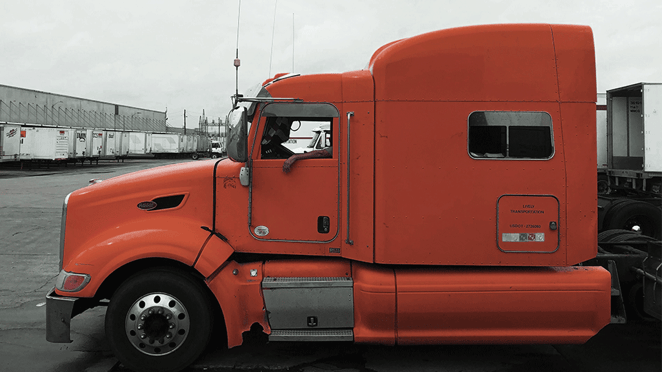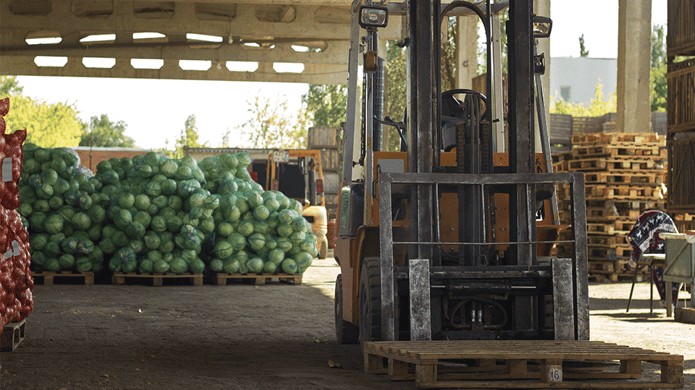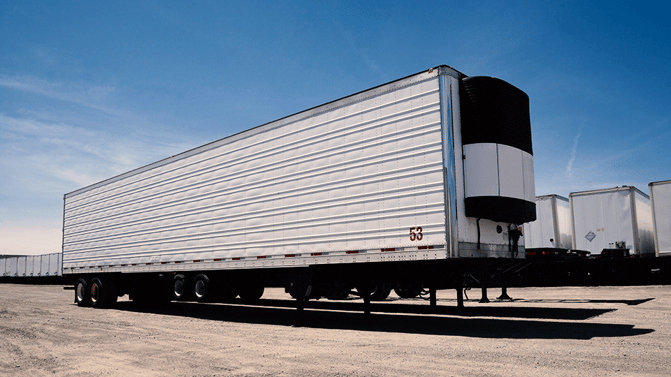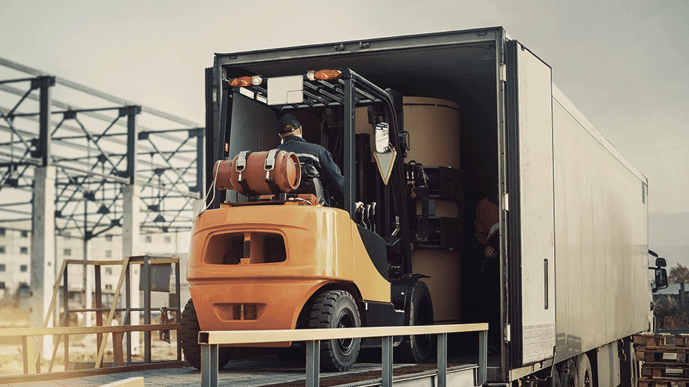Your business, which spends its days making sure store shelves are lined, dinner reservations are valuable and refrigerators are stocked with everything from cool apple cider to fresh bell peppers, couldn’t be more important.
That said, accomplishing these tasks isn’t always easy — especially with the perishable nature of many food products. Producing, transporting and distributing food-grade commodities is a fast-paced, unforgiving endeavor.
Without proper planning and oversight, it’s not uncommon for issues like cargo damage, temporary delays and failed shipments to occur. These mishaps leave companies like yours with the unfortunate reality of lost income and supply chain congestion. For people in your role, these events can be both discouraging and exhausting — dissuading you from continuing your vital work.
Here at Anderson Trucking Service, we respect the important role food and beverage companies play in feeding the world. And, we take pride in being a steady-handed ally for these businesses to trust with their transportation activities.
For over 65 years our experiences with the food and beverage industry have taught us many things including how to price these loads, how seasonality makes things tricky, which freight-movement processes don’t work and which ones do.
To help you manage the movement of your food, beverages, or a combination of the two, this article will outline two things:
- Give you three ways to make your shipments run as smooth as possible.
- Outline three of the most common food and beverage transportation mistakes to avoid.
Although the food and beverage industry is about as complex as it gets — particularly when it comes to the rules and regulations governing it — this article will give you a wide range of tactics for managing the transport of a wide range of products. And, in the end, you'll walk away with greater comfort making transportation decisions for your freight.
3 Ways To Make Your Food And Beverage Shipments As Smooth As Possible
Look, you have a lot on your plate. You have customer commitments to meet, paperwork that needs your attention, a budget to maintain and a myriad of moving parts to oversee. So, when it comes to the transportation of your shipments — the cargo that keeps American households well fed and your business’s lights on — it’s understandable if you’ve had trouble keeping everything on track in the past.
To help you keep your transportation supply chain running as smoothly as possible in the future, though, here are our three best tips:
- Increase the efficiency of your loading/offloading times.
- Select carriers that adhere to all food-grade transportation standards.
- Increase your access to flexible capacity that matches your needs.
Carefully monitoring and putting time toward each of these endeavors will make an impact on your bottom line and the efficiency of your transportation procedures going forward.
Let’s talk a little bit more about how you can prioritize these things in your food and beverage transportation supply chain and the importance of doing so.
1. Increase The Efficiency Of Your Loading/Offloading Times
Food and beverage companies, and the cargos they ship, rarely have time to spare.
Practically everything sold on store shelves, from cartons of milk to farm-to-table produce, has a firm expiration date. Getting these items onto store shelves in a timely manner. . . well, that’s where you come in.
It’s imperative that your loading times — the periods bridging the gap between the moment a transportation solution pulls up to your door and the second it leaves — don’t impact the freshness or quality of each load.
That said, without proper planning and management some serious issues could arise. You see, truck drivers are subject to a strict set of guidelines — known universally as their hours of service (HOS). These rules and regulations, set by the federal government, limit the number of hours each driver is allowed to be actively on duty.
As it currently sits, HOS rules limit a driver’s on-duty service hours to 14 within a 24 hour period of time. These 14 hours start as soon as a driver turns the key on their tractor — indicating the start of their shift — and expire exactly 14 hours later.
This clock doesn’t stop while a driver is getting loaded or offloaded and every 14-hour shift must be followed by a 10 hour rest period. As such, should prolonged loading or offloading procedures deem it necessary, some shipments must be delayed while a driver resets their HOS.

For food and beverage companies, particularly those who move temperature-controlled commodities, these 10 hours of respite can be especially damaging. Though detention fees — levied at a rate ranging between $50-$100 per hour — can certainly add up, in many instances, they are the least of a food and beverage shipper’s concerns.
Instead, the on-time arrival and safe transportation of sensitive cargo (goods like ice cream, raw meats and produce) top that list.
To avoid any potential issues, stemming from prolonged, inefficient loading times and procedures, here are three tactics to employ:
1. Consider Adding Part-Time Workers
Sometimes a couple of extra hands can make all the difference. If you face issues getting items out the door efficiently — which can be especially challenging during your peak seasons — consider bringing on some help during these periods.
Many food and beverage shippers find it beneficial to have a few more workers floating around to assist with pick and pack loading procedures and keep everything on track.
Although the expense of adding some part-time, or full-time, help might seem like a deterrent, having additional workers around may actually save you money by ensuring you avoid unnecessary detention fees, delays and product damage.

2. Develop Systems for Product Staging
Often, loading freight takes longer because locating the appropriate products within your facility is challenging. And, as the volume of products leaving your doors increases — as it does during your high season(s) — efficiently finding and loading goods only becomes more difficult.
To avoid these issues when things pick up, begin to develop systems for sorting, storing and staging products. When done correctly, staged products will help your workers expeditiously load trailers when they show up — keeping everything on schedule in the process.
3. Consider Utilizing Drop Trailer Programs (Non-Temperature Controlled)
In recent years, some of the largest food and beverage companies have added drop trailer programs to their transportation processes. Drop trailers give shippers the ability to pre-load trailers — at whatever time works best with their production schedules — and keep their cargo moving without delay as all a driver needs to do is hook up to the previously-loaded trailer and hit the road.
2. Select Carriers That Adhere to Food-Grade Transportation Standards
On April 6, 2017, the Food and Drug Administration (FDA) passed its Food Safety Modernization Act. This rule was drafted, and published, by the FDA to prioritize the safety, and safe handling, of all food designated for both human and animal consumption.
As a food and beverage shipper, these rules and regulations may apply to you. You see, this Food Safety Modernization Act (FSMA) was created to promote the safety of all parties that would ever consume potentially harmful food-grade products.
And, to do so, the FSMA has a specific set of guidelines for the safe transportation of these cargos. If your company moves raw beef, poultry or any product that has the potential to cause food-borne illness without proper handling, the FSMA applies to you and the transportation companies you utilize.

Though Food Safety Modernization Act lists seven major rules each company must adhere to during the production, handling and distribution of these cargos, here is what you need to know as it relates to their transportation:
- Vehicles and transportation equipment: The design and maintenance of vehicles and transportation equipment must ensure that the food they transport doesn’t become unsafe. For example, all equipment must be suitable, adequately cleaned for their intended use and capable of maintaining temperatures necessary for the safe transport of food.
- Transportation operations: All measures taken during transportation must ensure food safety — such as adequate temperature controls — prevent contamination of ready to eat food from touching raw food, protect food from contamination by non-food items in the same load, or on a previous load, and protect food from cross-contact to avoid the unintentional incorporation of a food allergen.
- Training: Training of carrier personnel in sanitary transportation practices and documentation of each training session.
- Records: Maintenance of records of written procedures, agreements and training. Records of temperature control monitoring, specific load information with shipper requirements each carrier must follow and documentation of loss or potential loss/recall of load.
Related: What Does the Food Safety Modernization Act (FSMA) Mean For Transportation?
To keep your supply chain on track and ensure that your reputation for safety is secure, you’ll want to ensure that every carrier you use adheres to these specific standards.
For this reason, be sure to ask your carrier questions about their safety practices:
- How do they make sure every driver is properly trained for transporting food-grade products?
- Do they have systems in place for sanitizing trailers and equipment after every load?
- Have they ever moved your commodity before? If so, do they have a preferred method for loading and securement?
- What steps do they take to make sure all of their equipment (and reefers in particular) are properly maintained and cared for?
The way a carrier answers these, and questions like these, should give you a solid grasp on their level of expertise. And, in the food and beverage industry, you’ll want a network brimming with expert providers.
3. Increase Your Access to Flexible Capacity That Matches Your Needs
Sometimes food and beverage production and distribution periods are cyclical by nature. Influenced by changes to buyer patterns and seasonal shifts, these companies see their demand for transportation capacity swell and fall — somewhat predictably.
If this sounds familiar, then you understand how impactful flexibility can be when managing your supply chain. Acquiring elastic transportation capacity to match your changing needs starts with the providers you choose.
Make sure to build your network based on your changing needs. Find asset carriers and freight brokers that are capable of changing with you. Transportation is a fast-moving industry brimming with intricacies and adjustments.
By understanding the ebbs and flows of your cycles, you’ll be able to match the overarching needs of your business to the strengths of your network.
Here’s what I mean:
The greatest providers recognize the changing needs of their customers and have systems in place for meeting these demands.
That said, every transportation provider has established areas of strength.
These are areas, regions and/or locations in which this company is strongest. In these locations — bracketed by well-rounded infrastructure, a customer base and extensive trucker domicile — they can offer competitive pricing and reliable service.
Even in the busiest of times and on the shortest of notice, trucking companies — which must uphold their commitment to keeping drivers loaded and moving — can help their customers secure capacity within these areas.
As a shipper’s requirements edge away from these regions, however, a carrier’s ability and willingness to move shipments may falter. Without the established infrastructure their strong areas offer, many carriers simply can’t meet capacity demands or price their services as competitively as others.
For this reason, when building your food and beverage transportation network, it’s important that you verify each prospective provider’s area(s) of strength and choose accordingly.
A network filled with companies that have different strengths and weaknesses will help you cover your changing transportation needs — no matter how demanding they become.
3 Mistakes To Avoid When Moving Food and Beverage Freight
Accidents happen. Even the best in the business make mistakes. The trick to getting ahead, outpacing the competition and expanding your market share is to limit these mishaps.
The food and beverage industry, like many others, makes it easy for external companies, like ours, to pinpoint the most common set of these issues — issues that happen more frequently than the field. To get the most from your business in the days, weeks, months and years ahead, you’ll want to avoid mistakes wherever possible.
Without knowing where to look or what categorizes these activities as mistakes, however, avoiding them is next to impossible. So here’s what you need to know. . .
The 3 most common, and avoidable, mistakes shippers in the food and beverage industry make — when it comes to their transportation activities — are:
- Using bad packaging.
- Over-loading the trailers they utilize.
- Leaning on the help and expertise of inexperienced providers.
1. Using Bad Packaging
Many kinds of food and beverage freight are delicate. These cargos need to be properly insulated, wrapped and protected during transit. Without ensuring that goods are packaged in the best way possible, cargo claims and the rejection of a product at its endpoint can occur.
Although the onis of ensuring freight is in good condition upon arrival falls primarily on the carrier, goods that aren’t properly packaged make this exponentially more difficult.
For this reason, ensure that you understand your cargo’s packaging needs: do these pallets need to be wrapped with cardboard for insulation?; Is it possible to add pre-cooling to your procedures?; Would crates be a better packaging solution?.
Standardizing proper packaging will help you ensure the sustained quality of your products following transport. Should you have any questions on best practices where this is concerned, reach out to a trusted transportation expert. The best trucking companies and freight brokers have been moving food and beverage freight at a high clip for decades and will have no trouble helping you get your packaging right.
2. Over-Loading Trailers
The federal government — namely the Federal Motor Carrier Safety Administration (FMCSA) — sets the threshold for gross maximum vehicle weight at 80,000 pounds. This maximum weight limit includes the total poundage of a fully-loaded trailer and the truck used to haul it.
This limit, set to keep the motoring public and roadways safe from harm, is heavily enforced in the transportation world — with drivers tested at weigh stations regularly.
Because a large portion of food and beverage cargos are perishable in nature, it‘s not uncommon for under-prepared shippers to try and expedite their supply chains by over-loading a trailer. More often than not, however, this tactic backfires.

Instead of helping these companies get products to their destinations faster, over-loading a trailer can sometimes force drivers to return to that shipment’s origin to unload extra commodities because they were found to be too heavy at a weigh station.
Cut out this extra handling period and the potential cargo damage stemming from it by properly loading each trailer that pulls up to your dock. Abide by the legal weight limits set by the FMCSA and, in turn, expedite your supply chains.
3. Leaning On The Help Of Inexperienced Providers
Like any other business, the transportation world is full of varying levels of reliability.
Some providers come through on their word, providing the service levels they promised and meeting customer demands. Others don’t hold to these same standards, prioritizing turning a profit over creating unique value for each and every customer.
When filling your food and beverage transportation network with great companies, be sure to only include the most experienced carriers. With their knowledge-base and well-rounded expertise — forged through years of trial, error and optimization — in your corner, getting more from your budget will be more than attainable.
To help you choose companies that will soundly match your needs, we’ve put together a pair of tools for your use:
| The Freight Carrier Vetting Guide | The Freight Brokerage Selection Checklist |
A Final Note About Food and Beverage Shipping
Now that you have these three tactics for food and beverage shipping success and three common mistakes to avoid, your transportation processes should operate a bit smoother going forward.
That said, if your business ships temperature-controlled frieght, your pricing might be more complex than a dry van shipment, for example.
You see, reefer shipping is a delicate process that, without well-maintained equipment and proper planning, can quickly unravel. For this reason, refrigerated transportation services can be more costly.
These price hikes, however, are directly correlated to the type of temperature-controlled service you need — be it protect-from-freeze, fresh or frozen.
To give you a better understanding of how your freight's temperature and its cooling-unit setting impacts the final price of these loads, read our article on this topic: How Does Temperature Impact Reefer Shipping Price?
Finally, if you'd like to discuss how ATS can help you meet your food and beverage transportation goals, check out our Food and Beverage Transportation page and contact us for some more information.




